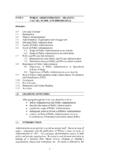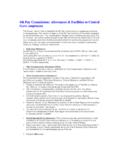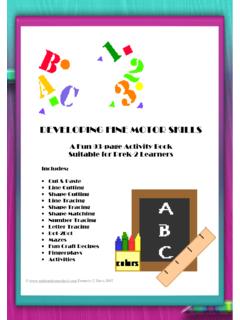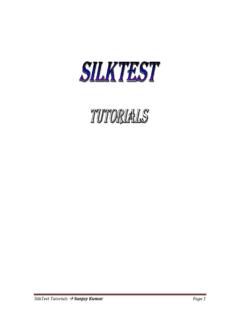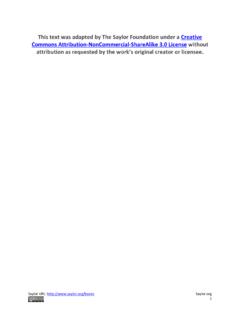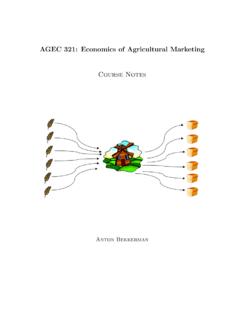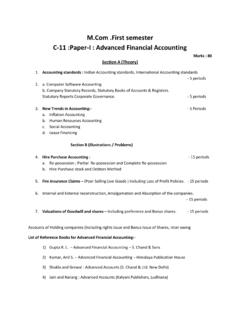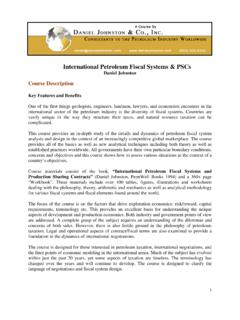Transcription of ECONOMICS WORKBOOK PAGE 2 OF 158 …
1 ECONOMICS WORKBOOK PAGE 2 OF 158 DEMIDEC 2008 ECONOMICS WORKBOOK 2008 2009: Latin America Table of Contents I. Fundamentals of 3 II. Microeconomics .. 36 III. Macroeconomics .. 87 IV. International Trade & economic Development .. 131 About the Author .. 144 About the Editors .. 144 Answer Key .. 145 Jessica Raasch Arizona State University 07 edited by Dean Schaffer and Daniel Berdichevsky William Howard Taft High School Stanford University reviewed and updated by Lawrence Lan Palos Verdes Peninsula High School Cornell University DemiDec and The World Scholar s Cup are registered trademarks of the DemiDec Corporation. Academic Decathlon and USAD are registered trademarks of the United States Academic Decathlon Association. DemiDec is not affiliated with the United States Academic Decathlon. ECONOMICS WORKBOOK PAGE 3 OF 158 DEMIDEC 2008 I. Basics of ECONOMICS This section covers everything in Section I of the curriculum outline except for topics related to trade, which are found in Section IV.
2 Material on the Mexican Economy is contained in its own WORKBOOK . Microeconomics and ECONOMICS is a study of decision-making. It can be divided into two broad areas of study. In microeconomics, we study the economic decision-making of the individual and the consequences of those decisions. We isolate individual markets and we try to explain how they function and what will cause their behavior to change. In macroeconomics, we study the behavior of an economy as an aggregate, or as a whole. We might try to measure the size of the economy or we might try to assess its health. We might also try to predict how a policy change could affect the economy. THINK FAST Spit it out. In five or fewer words, what is ECONOMICS ? _____ CATEGORIZATION The big picture. Below is a list of topics in the study of ECONOMICS . Determine whether each topic is in the area of microeconomics ( Micro ) or macroeconomics ( Macro ).
3 Circle your answer choices. Ex. Micro Macro How an individual decides which brand of cereal to buy 1. Micro Macro How the Federal Reserve influences consumer spending in the Micro Macro How a household decides which brand of laundry detergent to buy3. Micro Macro How a firm decides when to go outof business 4. Micro Macro How debt affects the income gap among Americans 5. Micro Macro How new parents decide whether to work or stay home with their children ECONOMICS WORKBOOK PAGE 4 OF 158 DEMIDEC 2008 The Basic economic We begin our study of ECONOMICS with the problem of scarcity. We experience scarcity when there is less of something available to us than we d like. It might be food, time, or just about anything. Even if a resource is given away for free, it is scarce if people want more of it than what is available to them.
4 Scarcity and Choice Scarcity is the basic problem of ECONOMICS . We can t have everything we want, so we re forced to choose among alternatives. In other words, scarcity forces us to make choices. ECONOMICS is the study of how we make those choices. When we study ECONOMICS , we presume people are dealing with scarcity; we presume they are constantly struggling to balance unlimited wants with limited resources. Some resources seem to be abundantly available to everyone, so we have trouble seeing them as limited. These are termed free goods. Air is the most common example of a free good, because we all breathe as much air as we need. However, an economist will tell you nothing is free, not even air (and certainly not oxygen, which is now sold in small, presumably invigorating quantities at oxygen bars.) If we give it enough thought, we see that everything has a cost.
5 As the saying goes, There Ain t No Such Thing As A Free Lunch (TANSTAAFL). Even the air we breathe has a price tag. After all, we pay taxes to support the environmental regulations that help keep our air breathable. FILL-IN Fill er up, Phillip . Complete these statements by writing in the missing words. The first statement has been completed for you. 1. There ain t no such thing as a free lunch (TANSTAAFL). 2. ECONOMICS is based on the assumption that people have unlimited _____ and limited _____. 3. The basic problem of ECONOMICS is _____. 4. If less of a resource is available to us than we like, then the resource is said to be _____. 5. The most common example of a free good is _____. Opportunity Cost and In order to make use of our scarce resources, we have to choose to have some things and to do without others. A trade-off is a decision to have something and to do without something else.
6 Suppose you choose to go on a cruise, rather than take a backpacking trip to Machu Picchu. Your decision is a trade-off. By opting for the cruise, you decide to have the luxury of sleeping in late, eating extravagant meals, and breathing the salty sea air. You also decide to do without the opportunity to walk among ancient Incan ruins and to breathe the crisp mountain air of the Andes. The opportunity cost of a decision is the value of the best alternative not chosen the value of the thing you could have had, but didn t. If backpacking to Machu Picchu is the best alternative to a cruise, then the opportunity cost of the cruise is the value to you of the backpacking trip. It s the cost of the lost opportunity. When evaluating alternative solutions to a problem, economists want to consider all the relevant costs involved. Some costs are obvious because they require an outlay of cash.
7 Others are less obvious. You re probably familiar with what an economist would call an accounting cost. It s the amount that is actually paid in exchange for a good or service; it s also known as explicit cost. However, an economist is most concerned with the economic cost of a decision. The economic cost of a decision is the complete cost, which is a measure of its net economic impact. This includes the accounting cost and the opportunity cost, as well as other less-obvious costs, like the value of lost product quality or the value of a change in employee morale. All costs that are not accounting costs are also known as implicit costs. Of course, the value of a ECONOMICS WORKBOOK PAGE 5 OF 158 DEMIDEC 2008 change in quality can be difficult to quantify, so the economic cost of a decision is not something we can easily express in dollars.
8 IN BRIEF Short answer. Write a brief response to each question below. 1. What is the basic problem of ECONOMICS ? _____ 2. According to economists, why do people have to make choices? _____ 3. Why do economists say There ain t no such thing as a free lunch ? _____ 4. What is a free good? _____ 5. What is a trade-off? _____ 6. What is the opportunity cost of a decision? _____ 7. What is the difference between accounting cost and economic cost? _____ 8. Why is it difficult to quantify the economic cost of a decision? _____ _____ TEST-TAKING TIP In your mind, you should link the terms trade-off and opportunity cost. Also, link opportunity cost with the phrases did not choose and chose not to. On an exam, if you see one term from a linked pair in a question stem, the other one could be lurking in the correct answer choice. Here is an example: Bob made a trade-off when he chose a job located close to his home over a job he loved.
9 The value of working a job he loved was his a. alternative cost b. economic cost c. opportunity cost d. marginal benefit e. marginal cost ECONOMICS WORKBOOK PAGE 6 OF 158 DEMIDEC 2008 EXAM PRACTICE Is this gonna be on the test? The questions below are similar to those that have appeared on Decathlon exams in the past. In this exercise, you ll practice outsmarting them. First, in each question, underline the phrases you know to link together. Then, circle the letter of the correct answer choice. 1. The cost of a trade-off is known as its a. opportunity cost b. trade-off cost c. explicit price d. real value e. future cost 2. A firm can produce T-shirts or sweatshirts. The opportunity cost of the firm s decision to produce T-shirts is BEST measured by the a. fixed costs of T-shirt production b. variable costs of T-shirt production c. price of the T-shirts produced d. number of sweatshirts the firm chose not to produce e.
10 Total costs of T-shirt production MATCHING It s better than clashing. Match the letter of each term in the column on the left to the BEST description in the column on the right. Write your answers in the blanks provided. An example has been completed for you. a. opportunity cost b. scarcity c. economic cost d. increase in insanity e. free good f. trade-off g. individual h. aggregate a decision to have more of one thing and less of another 2. _____ the scale of the study of microeconomics 3. d a negative externality of working for DemiDec for seven years 4. _____ equal to the value of the best alternative not taken 5. _____ a measure of the net economic impact of an action 6. _____ the scale of the focus of macroeconomics 7. _____ available in a sufficient quantity to anyone who wants it 8. _____ the reason we study ECONOMICS The Production of Goods and A trade-off decision is not usually as simple as choosing which vacation to take.

